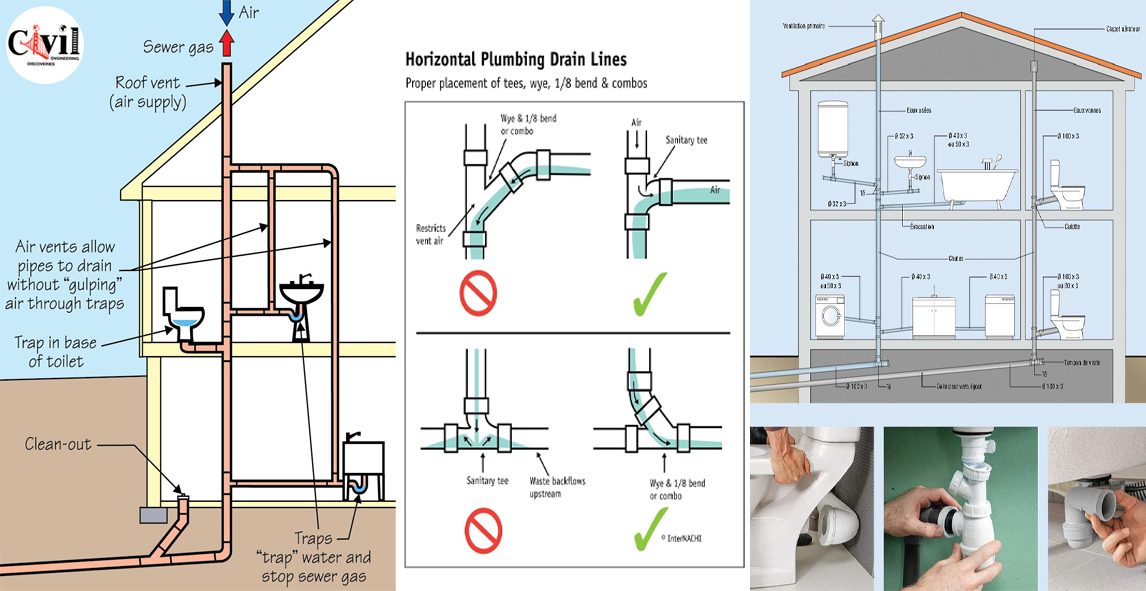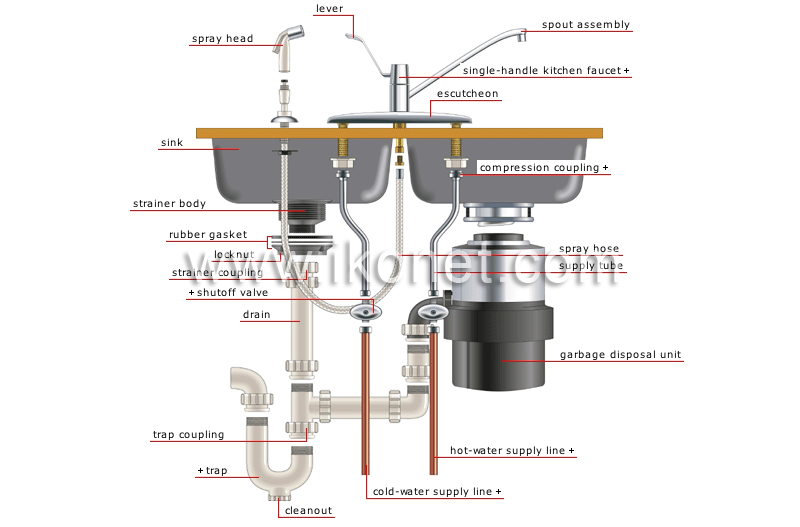Key Components of Your Home's Plumbing System
Key Components of Your Home's Plumbing System
Blog Article
Here in the next paragraphs you can locate a bunch of extremely good material in regards to Exploring Your Homes Plumbing Anatomy.

Comprehending just how your home's plumbing system works is necessary for every home owner. From providing clean water for drinking, food preparation, and bathing to securely eliminating wastewater, a well-maintained plumbing system is crucial for your family's health and wellness and convenience. In this extensive overview, we'll check out the complex network that makes up your home's plumbing and deal suggestions on maintenance, upgrades, and taking care of typical concerns.
Introduction
Your home's pipes system is more than simply a network of pipes; it's a complicated system that guarantees you have access to tidy water and efficient wastewater removal. Understanding its elements and just how they work together can assist you protect against expensive repair work and guarantee whatever runs efficiently.
Basic Parts of a Plumbing System
Pipelines and Tubes
At the heart of your pipes system are the pipes and tubing that bring water throughout your home. These can be constructed from various products such as copper, PVC, or PEX, each with its benefits in terms of sturdiness and cost-effectiveness.
Components: Sinks, Toilets, Showers, etc.
Fixtures like sinks, bathrooms, showers, and bath tubs are where water is used in your home. Comprehending just how these fixtures connect to the plumbing system aids in diagnosing troubles and planning upgrades.
Shutoffs and Shut-off Points
Shutoffs control the flow of water in your plumbing system. Shut-off shutoffs are critical during emergencies or when you require to make fixings, allowing you to isolate parts of the system without interrupting water flow to the entire house.
Supply Of Water System
Main Water Line
The main water line connects your home to the local water system or an exclusive well. It's where water enters your home and is dispersed to various fixtures.
Water Meter and Pressure Regulator
The water meter steps your water usage, while a pressure regulator makes sure that water streams at a safe stress throughout your home's plumbing system, avoiding damage to pipes and fixtures.
Cold Water vs. Warm water Lines
Understanding the distinction between cold water lines, which provide water straight from the major, and warm water lines, which lug warmed water from the hot water heater, aids in repairing and planning for upgrades.
Drain System
Drain Pipeline and Traps
Drain pipes carry wastewater away from sinks, showers, and toilets to the sewage system or septic system. Catches avoid sewer gases from entering your home and additionally catch particles that might create clogs.
Air flow Pipes
Ventilation pipes allow air right into the water drainage system, stopping suction that might slow down drainage and cause catches to vacant. Appropriate ventilation is vital for keeping the integrity of your plumbing system.
Relevance of Appropriate Drainage
Ensuring appropriate drain prevents back-ups and water damage. Routinely cleansing drains pipes and maintaining traps can protect against expensive fixings and extend the life of your pipes system.
Water Heater
Types of Hot Water Heater
Water heaters can be tankless or standard tank-style. Tankless heating units heat water as needed, while storage tanks store warmed water for instant use.
Just How Water Heaters Link to the Plumbing System
Comprehending how hot water heater link to both the cold water supply and hot water circulation lines assists in detecting problems like insufficient warm water or leaks.
Upkeep Tips for Water Heaters
On a regular basis flushing your hot water heater to eliminate debris, inspecting the temperature level setups, and examining for leakages can prolong its life-span and enhance energy effectiveness.
Common Pipes Issues
Leakages and Their Causes
Leakages can occur because of aging pipes, loose fittings, or high water stress. Dealing with leakages quickly protects against water damage and mold and mildew growth.
Obstructions and Blockages
Blockages in drains pipes and commodes are typically brought on by flushing non-flushable products or a build-up of oil and hair. Using drainpipe screens and being mindful of what drops your drains can avoid obstructions.
Signs of Plumbing Issues to Expect
Low water pressure, sluggish drains pipes, foul odors, or abnormally high water bills are signs of prospective plumbing troubles that must be addressed promptly.
Plumbing Maintenance Tips
Normal Inspections and Checks
Schedule yearly pipes inspections to capture issues early. Look for indications of leakages, corrosion, or mineral buildup in faucets and showerheads.
DIY Upkeep Tasks
Straightforward jobs like cleansing faucet aerators, checking for bathroom leakages utilizing color tablet computers, or protecting revealed pipelines in cold climates can avoid significant pipes concerns.
When to Call a Professional Plumber
Know when a plumbing issue requires expert know-how. Trying intricate repair services without proper knowledge can bring about more damage and greater repair service prices.
Updating Your Pipes System
Reasons for Upgrading
Upgrading to water-efficient components or replacing old pipelines can improve water top quality, decrease water bills, and raise the worth of your home.
Modern Pipes Technologies and Their Advantages
Discover innovations like wise leakage detectors, water-saving bathrooms, and energy-efficient hot water heater that can conserve money and decrease environmental impact.
Cost Factors To Consider and ROI
Compute the in advance expenses versus long-term financial savings when taking into consideration pipes upgrades. Lots of upgrades spend for themselves with decreased utility costs and less repair services.
Ecological Impact and Preservation
Water-Saving Components and Home Appliances
Setting up low-flow faucets, showerheads, and toilets can significantly reduce water use without giving up efficiency.
Tips for Decreasing Water Use
Straightforward routines like taking care of leaks without delay, taking shorter showers, and running full lots of washing and dishes can conserve water and reduced your utility bills.
Eco-Friendly Pipes Options
Think about sustainable pipes materials like bamboo for flooring, which is durable and environment-friendly, or recycled glass for counter tops.
Emergency situation Preparedness
Steps to Take Throughout a Plumbing Emergency
Know where your shut-off shutoffs are located and exactly how to switch off the water in case of a burst pipeline or major leak.
Relevance of Having Emergency Contacts Convenient
Maintain contact details for local plumbing professionals or emergency solutions readily offered for quick response during a pipes dilemma.
Do It Yourself Emergency Fixes (When Suitable).
Short-lived repairs like utilizing air duct tape to patch a dripping pipe or positioning a container under a leaking faucet can lessen damage till a professional plumbing professional shows up.
Verdict.
Comprehending the makeup of your home's plumbing system equips you to preserve it successfully, saving money and time on repairs. By following regular upkeep routines and remaining notified about contemporary pipes technologies, you can ensure your pipes system runs efficiently for many years ahead.
HOW YOUR PLUMBING SYSTEM WORKS
Which Pipes Do What?
Blue lines = fresh water supply entering the building
Red lines = hot water supply entering the building
Grey lines = pipes carrying waste away from the building and venting pipes carrying gases away from the building (through the roof)
YOUR MAIN PLUMBING SYSTEMS
There are two main plumbing systems that support your home s basic plumbing needs one that brings clean water into your home, and one that sends dirty water away from your home. Connected to the toilet, bath, shower, and other faucets in your home, these two systems keep your water flowing in the right directions.
ACCESSING FRESH WATER
Fresh and clean water is brought into your home through the main water supply line . Filtered through one pipe, this water is pressured to flow into the various fixtures in your home at any given time.
This water can be sourced from a well located on your property, a pond or river (mostly cottages), or, as in most cases, from the city s municipal water treatment centre. However, it is important to note that water that is untreated, such as the water siphoned from ponds or rivers, may not be safe to drink. Personal water supplies always need to be treated for hardness and contaminants before consumed.
MUNICIPAL WATER SUPPLIES
Improve taste and odour
Remove sediment
Eliminate hardness
Reduce chlorine
COLD WATER SUPPLY VS. HOT WATER SUPPLY
Cold water flows into your home or building through the service line, which then distributes hot or cold water to your fixtures. This line is most commonly run through a central column that runs floor to floor. Hot water runs in short and straight pipes as the longer the pipeline, the more heat that will be lost in the transfer. Having shorter pipes also allows residents to access hot water more quickly.
WASTE WATER SYSTEM
Your wastewater system is divided into two parts pipes that send wastewater away from your home and venting pipes that send sewer gas away from your home. Sewage water travels through pipes that flush the water and waste towards local sewers that are operated and managed by your city or town. Most sewer systems rely on gravity to move the wastewater to where it needs to go.
The further away from your toilet or sink, the larger wastewater pipes become. This allows for waste to be disposed of from various parts of your home or business at once without pipe blockages. The angle and flow of these pipes are also essential for keeping your waste pipes clear of build up.
https://harrisplumbing.ca/how-your-home-plumbing-system-works/

HOW YOUR PLUMBING SYSTEM WORKS
Which Pipes Do What?
YOUR MAIN PLUMBING SYSTEMS
There are two main plumbing systems that support your home s basic plumbing needs one that brings clean water into your home, and one that sends dirty water away from your home. Connected to the toilet, bath, shower, and other faucets in your home, these two systems keep your water flowing in the right directions.
ACCESSING FRESH WATER
Fresh and clean water is brought into your home through the main water supply line . Filtered through one pipe, this water is pressured to flow into the various fixtures in your home at any given time.
This water can be sourced from a well located on your property, a pond or river (mostly cottages), or, as in most cases, from the city s municipal water treatment centre. However, it is important to note that water that is untreated, such as the water siphoned from ponds or rivers, may not be safe to drink. Personal water supplies always need to be treated for hardness and contaminants before consumed.
MUNICIPAL WATER SUPPLIES
COLD WATER SUPPLY VS. HOT WATER SUPPLY
Cold water flows into your home or building through the service line, which then distributes hot or cold water to your fixtures. This line is most commonly run through a central column that runs floor to floor. Hot water runs in short and straight pipes as the longer the pipeline, the more heat that will be lost in the transfer. Having shorter pipes also allows residents to access hot water more quickly.
WASTE WATER SYSTEM
Your wastewater system is divided into two parts pipes that send wastewater away from your home and venting pipes that send sewer gas away from your home. Sewage water travels through pipes that flush the water and waste towards local sewers that are operated and managed by your city or town. Most sewer systems rely on gravity to move the wastewater to where it needs to go.
The further away from your toilet or sink, the larger wastewater pipes become. This allows for waste to be disposed of from various parts of your home or business at once without pipe blockages. The angle and flow of these pipes are also essential for keeping your waste pipes clear of build up.
https://harrisplumbing.ca/how-your-home-plumbing-system-works/
I am just very taken with Understanding Your Home's Plumbing Anatomy and I am praying you enjoyed our blog posting. Are you aware of another individual who is fascinated by the subject? Please feel free to promote it. Thanks so much for taking the time to read it.
Visit Our Website Report this page